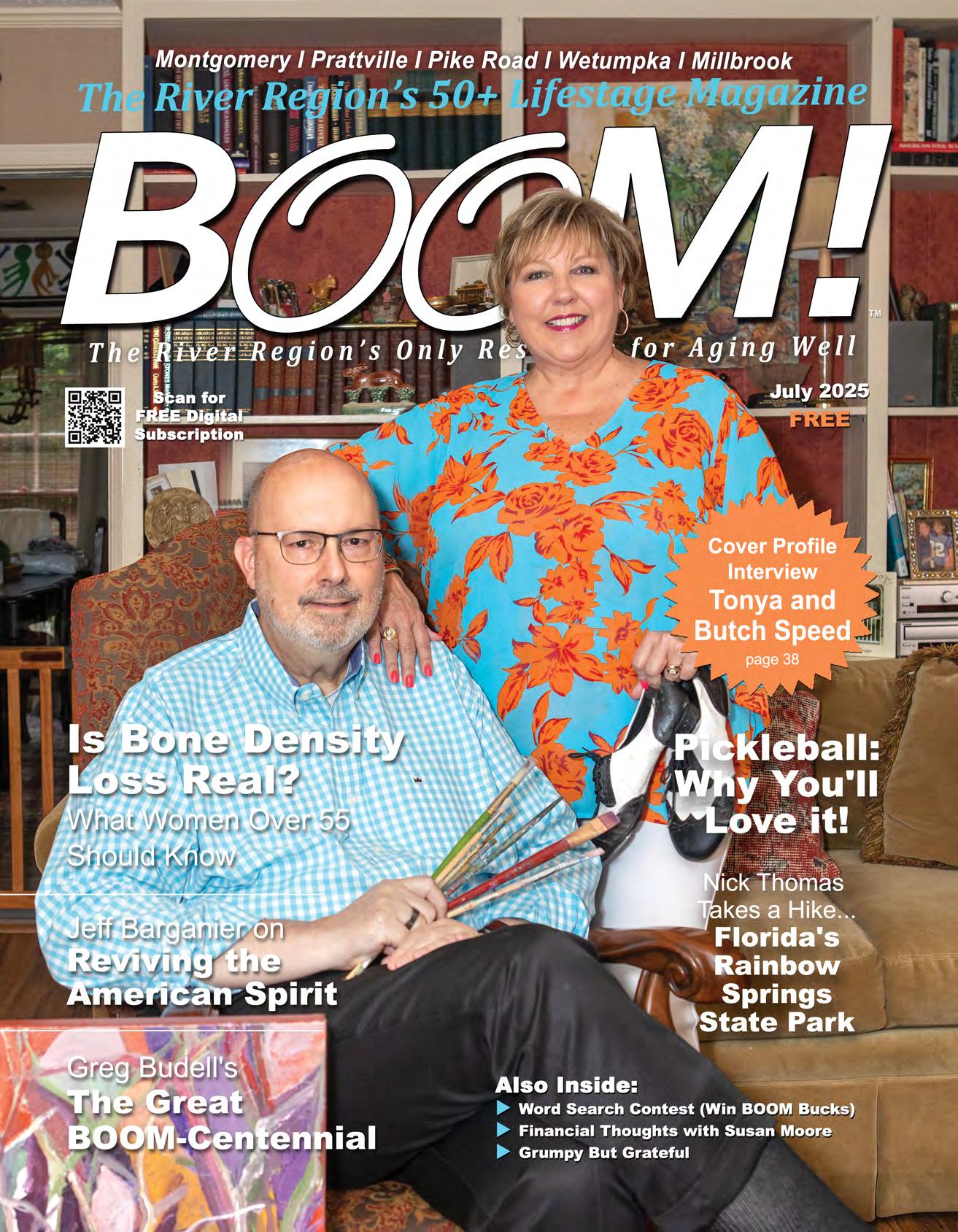
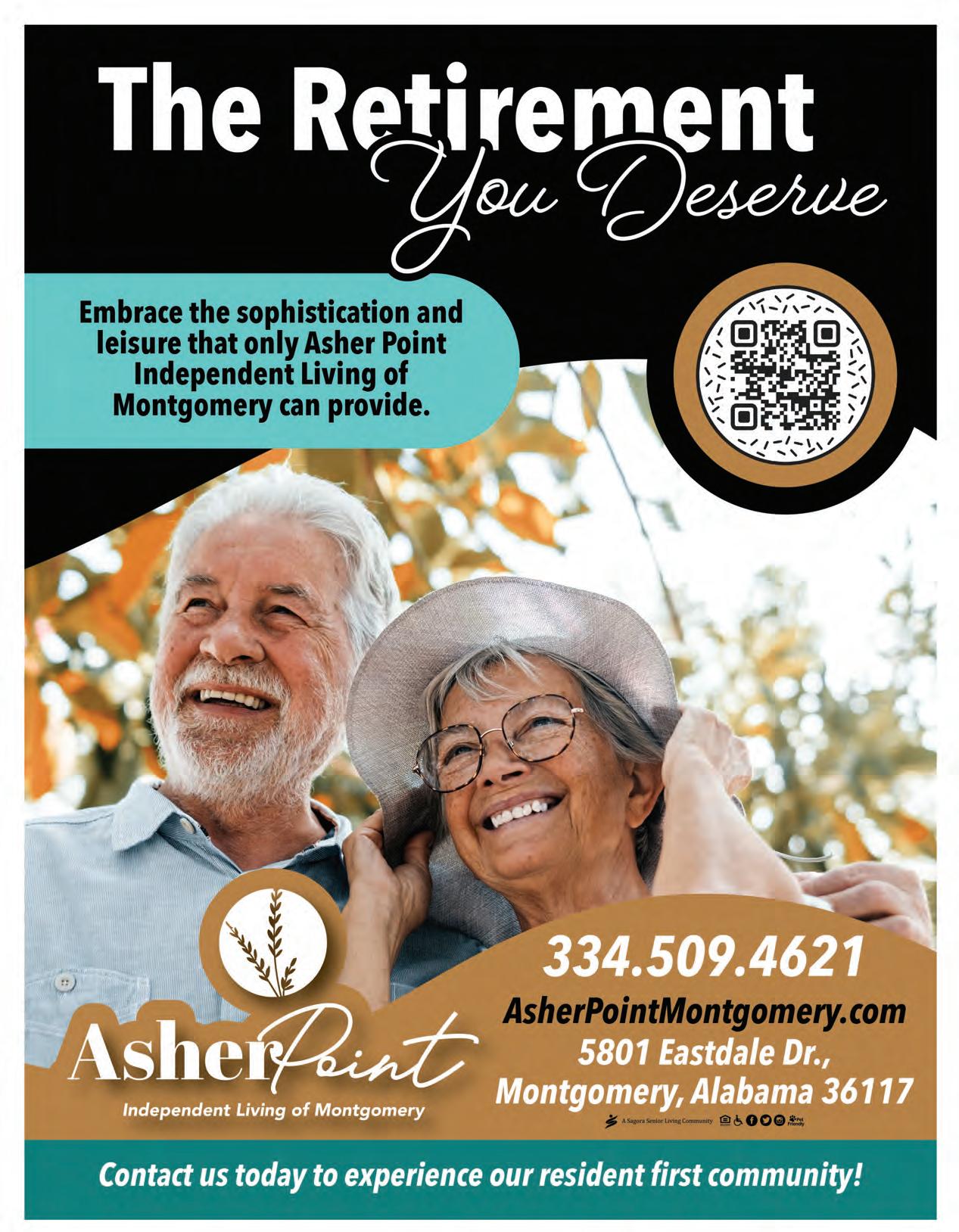


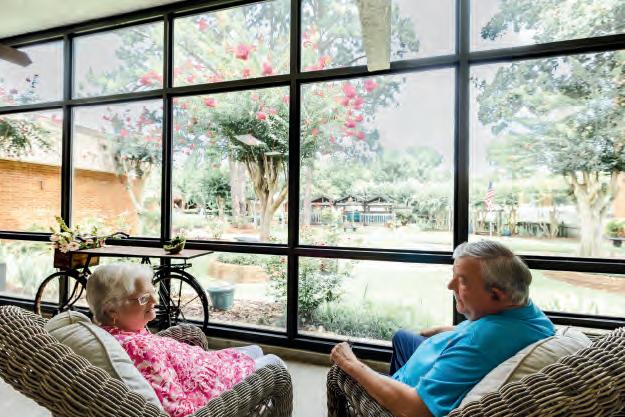


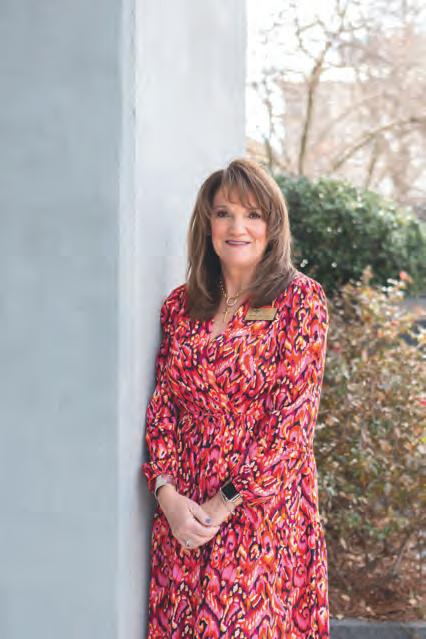















of Your Bladder—and Your Life— with Aquablation Therapy.
A breakthrough therapy for BPH now offered at Baptist Medical Center East.
Urinary symptoms from an enlarged prostate (BPH) can be frustrating and hard to talk about. But there’s a new solution. Aquablation Therapy is a minimally invasive, robotic procedure that uses a heat-free, high-pressure waterjet to precisely remove excess prostate tissue—with no cutting and no impact on sexual function. This advanced, personalized treatment helps reduce symptoms, restore bladder function, and improve quality of life.


Aquablation is helping men feel like themselves again—with fewer bathroom trips, more control, and better sleep. Find out if it’s right for you at BaptistBladderControl.com or by calling 334-747-7070.









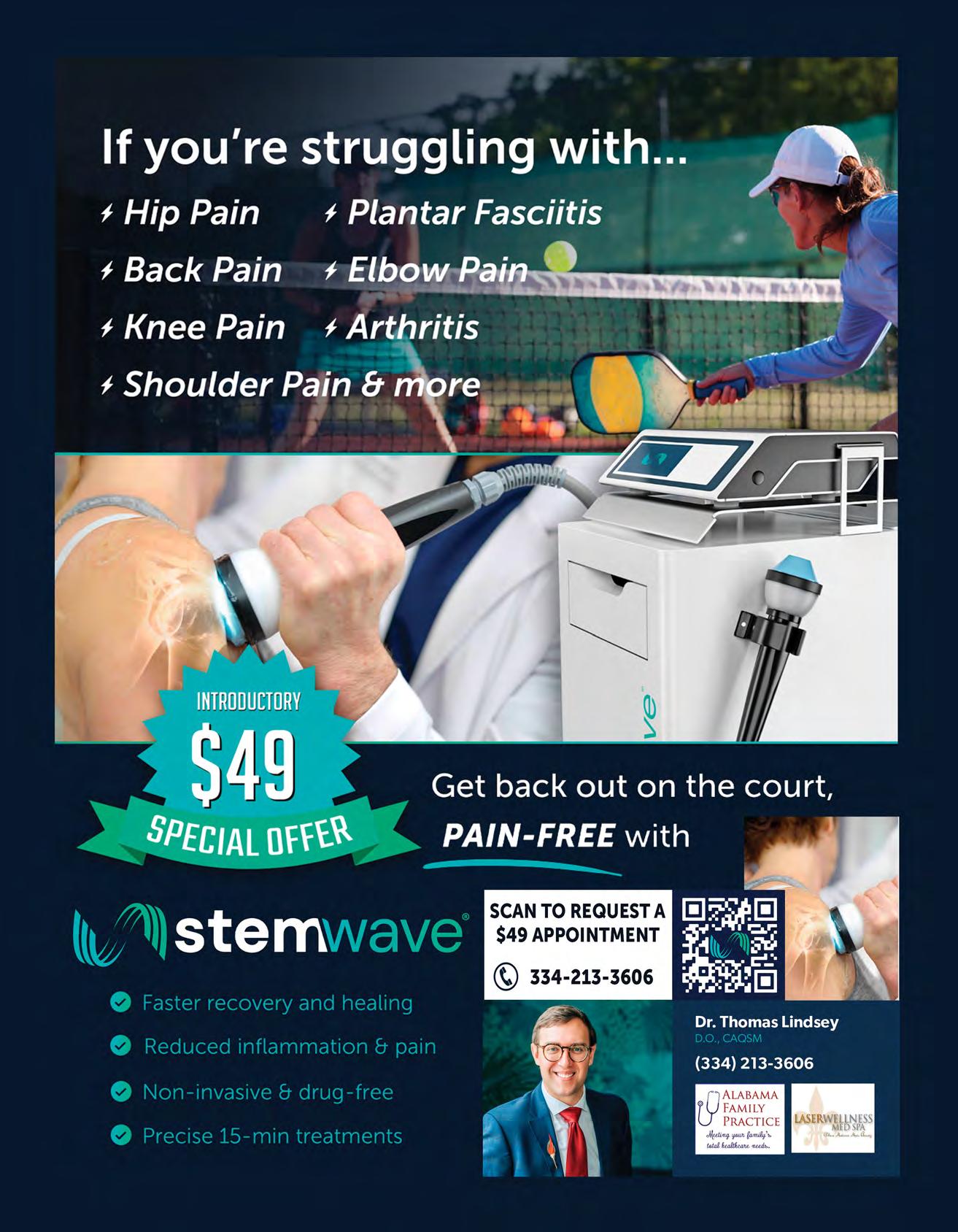

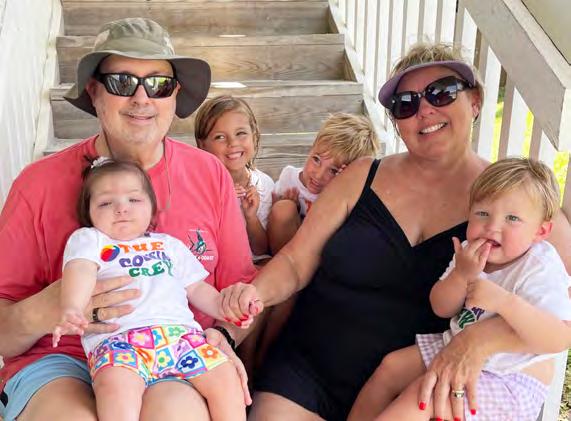





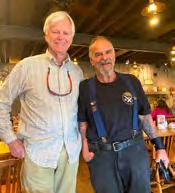



Dinner Recipe: Grilled Banana Ice Cream Sundae
Grumpy But Grateful
Event: Devon Allman Blues Summit
Event: Return of Elvis and Company
Event: Wetumpka's Annual Wine Pull
Event: Prattville's Creekwalk July Concerts
Event: Caregiver of the Month
Event: Tribute to the Eagles
Event: Midway Barn Bazarre
Event: Capitol City Golf Classic
Event: Montgomery Film Festival 16
Word Search Contest
Moore Wealth Management: "It Won't Happen to Me!"

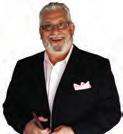
Founder Jim Watson (1950-2024)
Publisher Jason Watson
334.328.5189 cell/text jason@riverregionboom.com
Editor DeAnne Watson 334.462.0225 cell/text
Contributing Writers
Jeff Barganier
Greg Budell
Rebecca Hastings
Pam Molnar
Susan Moore
Nick Thomas
Cover Photography
Photography by DiAnna Paulk photographybydiannapaulk.com
Advertising
Jason Watson, 334.328.5189 jason@riverregionboom.com



Every July, we're reminded how bold and beautiful this grand experiment called America really is. And like any work in progress, we carry both the weight of our flaws and the hope of our potential. We've never been perfect—but that's never been the point. We are a people who press forward. Who right wrongs. Who lift one another. And who believe, even when it's hard, that freedom is worth fighting for—especially when it's used to pursue what is good.
This month's issue is filled with reminders of the best parts of that American spirit.
On our cover, you'll meet Tonya and Butch Speed, a couple whose 41-year marriage is as inspiring as it is real. Through dance, art, education, caregiving, and creativity, they've poured their hearts into generations of young people—and into one another. Even as Butch walks the road of Parkinson's, their faith, joy, and partnership continue to shine. They remind us what it means to age with purpose, to love through every season, and to keep creating beauty even in the face of difficulty.
Jeff Barganier takes us on a road trip that's much more than sightseeing. It's a glimpse at revival. At courage. At real Americans like Army veteran Johnny Longo—people whose lives reflect the grit, grace, and quiet strength that have always shaped this country from the ground up. If you're looking for hope in America, Jeff's story will help you find it.
We're also celebrating the joyful side of summer with ideas to keep you active and connected:
• Start your own Brunch Club and gather the people who matter most.
• Pick up a paddle and discover why Pickleball is America's fastest-growing sport—especially for Boomers.
• Hike with Nick Thomas to Florida's crystal-clear Rainbow Springs or climb to the panoramic heights of Kuwohi (formerly Clingmans Dome).
• And don't miss Greg Budell's hilarious look back at the Bicentennial and what our 250th might look like just around the corner.
This issue is a reminder that patriotism doesn't have to be loud or perfect. Sometimes, it looks like Tonya smiling at a young dancer who needs encouragement. Sometimes it's Butch showing up to mentor a student despite the tremors. Sometimes, it's brunch with neighbors, a walk in the woods, or a paddle across a pickleball court.
America's greatness was never in our power but in our people. And as long as we keep showing up—for each other, for our communities, and for the next generation—we'll keep moving toward that more perfect union.
Here's to freedom, family, and finding joy in every season.
Age Well, My Friends,

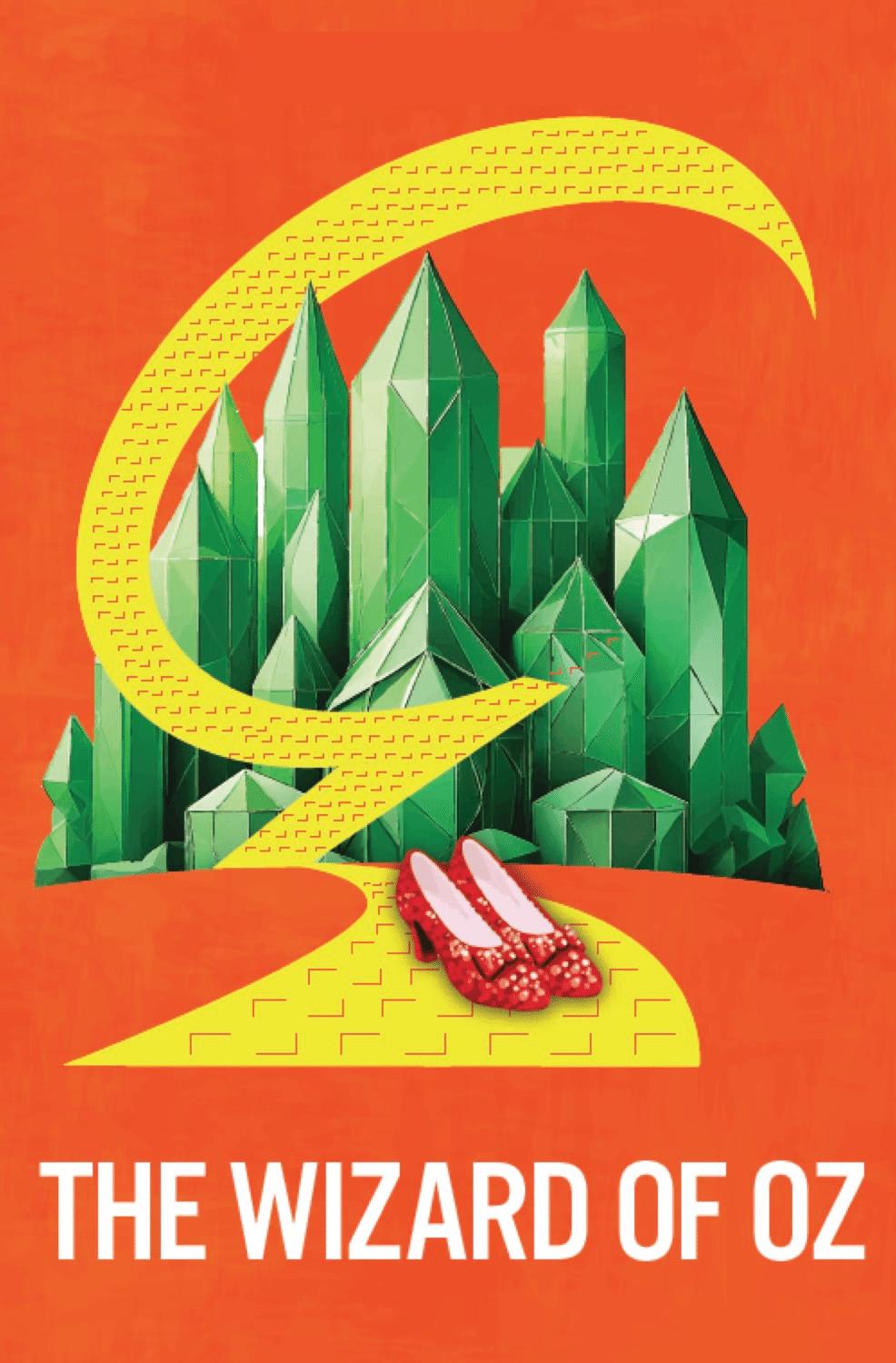
“I can’t find the Montgomery Botanical Gardens”! “I don’t see a sign for the gardens on Forest Avenue!”. Those have been repeated messages from potential visitors to our beautiful gardens. It is both sad and frustrating that there has been no sign to identify the location of the botanical gardens on Forest Avenue nor on the I-85 Interstate Exit at Mulberry Street. But one of those problems is about to be solved.

Ground has been broken, and construction has begun on the new Pedestrian Entrance to the Montgomery Botanical Gardens on Forest Avenue at the three-way intersection of Forest Avenue and Park Place. The impressive stone pillars on each side of the new entrance will support an arched sign designating Montgomery Botanical Gardens above them. The stone-faced pillars will appear very similar to the exterior of the Gayle Planetarium to blend with the environment and appear to have been there historically. The pillars will support an arched sign identifying the entrance to the Montgomery Botanical Gardens, with gates that will be opened and closed on the same schedule as the existing vehicle gate. Mr. Joe Hall, owner and stonemason of Appalachian Stone Company, is the builder and artisan who is leading this very needed project for MBG. Interestingly, Mr. Hall is a third-generation stone mason, and his grandfather was the stone mason who installed the attractive stone exterior of the Gayle Planetarium. Mr. Hall’s assistant, Mr. Wayne Pitchford, is a vital part of this work to create the new entrance.
Currently, the only entrance to the gardens is through the single-vehicle
entrance, which is not as safe or accessible for pedestrians to use. This new Pedestrian Entrance will do more than provide support for the MBG sign, which is very important. But it will also provide a much more convenient, safe, and accessible entrance for visitors to the gardens. The River Region Trails organization will be participating in the project with MBG not only with partial funding but also in helping to repair and replace the uneven sidewalk on each side of the entrance to be more accessible to people with mobility challenges, disabilities and those who use wheelchairs and walkers. One of the RRT planned trails will be established along Forest Avenue and pass by MBG. Patients, employees, and visitors from Jackson Hospital will be greatly assisted by the convenience
of this new entrance. The entrance is expected to be completed by the end of June, and a ribboncutting event will be announced.
The new Pedestrian Entrance will open into the recently installed Japanese Maple Garden and Hosta Garden. This is Phase II of MBG, which will also be the location of the historic JanneyCrane fountain that will be installed in the near future and will provide a peaceful spot for resting, meditating, and enjoying the pleasant sounds of water and nature. The pedestrian entrance is a significant development that will improve access, facilitate visitors and clearly identify the location of our beautiful botanical gardens in this urban area. Botanical Gardens in every city are major

attractions for tourists, businesses, and residents alike, and Montgomery Botanical Gardens is a significant asset to our city.

Ingredients:
¼ cup brown sugar
½ teaspoon cinnamon
2 bananas, peeled, halved and split lengthwise
1 tablespoon Mazola® Corn Oil
2 cups vanilla ice cream
½ cup strawberries, thinly sliced
¼ cup chocolate syrup
2 tablespoons sprinkles
Instructions:
1) Preheat grill to medium high heat.
2) Combine brown sugar and cinnamon in a small bowl.
3) Brush bananas with Mazola oil and sprinkle with cinnamon sugar. Add to grill and cook until fruit is browned and softened, about 2-3 minutes on each side.
4) Add vanilla ice cream and bananas to dessert bowls.
5) Top with strawberries, chocolate syrup and sprinkles.
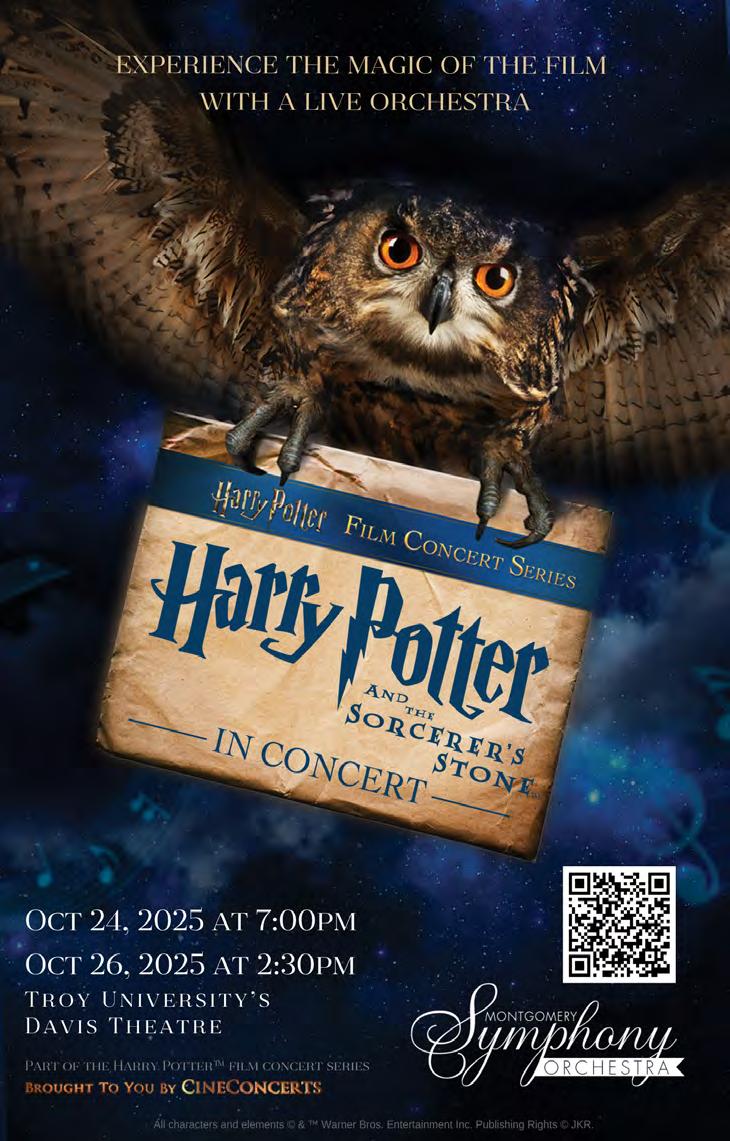


https://damndelicious.net/2013/07/03/grilled-banana-ice-creamsundae-and-a-giveaway/

Photography provided by Jeff Barganier
When an American church announces a homecoming picnic for its “online viewers” and people show up from 40 states and 4 foreign countries, does this reflect revival is in the air? It sure looked that way to me and Cindy when we attended an exciting May gathering at Leesburg, Virginia’s Cornerstone Chapel. Pastored by Gary Hamrick, the church had to cap online viewer attendance at 1000! Besides us, a small contingent of other folks from around Alabama were present.
When the Chinese Communist Party (CCP) unleashed COVID-19 on the world from a Wuhan, China lab—Anthony Fauci claimed it occurred naturally in nature—little did the CCP imagine they might be provoking a spiritual awakening in America.
many U.S. churches complied with “do not gather” orders and declined to hold worship services. Not Cornerstone Chapel. Under Hamrick’s leadership, Cornerstone continued to exercise its 1st Amendment freedom to gather, worship

God, and stream its services over the Internet. Consequently, its membership and online viewers expanded rapidly while some churches lost membership or died altogether.
This modern gathering of “technomembers” at Cornerstone reminded me of the more primitive “great awakenings” that took place on the American frontier. Two great awakenings have impacted American history. One occurred about thirty years before the American Revolution, setting the stage for the “Black Robe Regiment” of preachers who led American colonists in the fight against British tyranny.
The second broke out on the American frontier around 1800 during a period of lawlessness and debauchery. Concerned that westward expansion minus the moderating Word of God would lead to America’s demise, Christian evangelists migrated to Southern Kentucky and Northern Tennessee, boldly proclaiming the Gospel. It was during revival meetings at the Red River Meeting House near Adairville, Kentucky that the flames of the 2nd Great Awakening were ignited.
See: https://www.whitehouse.gov/lableak-true-origins-of-covid-19/
The COVID-19 pandemic exposed deep fault lines in the relationship between parents, public health institutions, the
Cindy interviewed an attendee from Athens, Alabama.
“You’re taking notes?” the lady asked with an inquisitive smile.
“Yes. My husband is writing a story about today’s event for Boom Magazine in Alabama.”

Christian Church and government. Under government threats and intimidation,
“Really? Oh … so, our church is in Athens. They use Pastor Gary’s verse by verse (method) for one of our women’s Bible studies. Who does verse by verse for the book of Judges? It’s like, how do I get through verse by verse in Judges?

But Pastor Gary does, and I was hooked! That was several years ago. We have a second place in Arizona. And Arizona’s not Alabama. We can’t find a church; so, when out there, we watch Cornerstone Chapel online.”
Frontier believers in the early 1800’s claimed that God had revealed to them the coming of a third great awakening. According to an interesting book by Glenda Orme Clark titled, A Table in the Frontier: Pioneers, Protestants & the Presence of God, God assured these early American pioneers that another great world-wide outpouring would come after the year 2000.
Perhaps churches like Virginia’s Cornerstone are the sprouting seeds of America’s third great spiritual awakening.
Virginia is a stunning state. When you hit Interstate 81 up around Pulaski and begin the drive northeast through the scenic Shenandoah Valley, nothing compares. They say Virginia is for Lovers. I don’t know about that. But I do, for sure,
believe Virginia is for lovers of history. Next issue, I’ll tell you about an amazing historic home—now a bed and breakfast—we discovered, where we slept in the same bedroom General
Robert E. Lee once slept in; and where Frederick Douglas’s portrait hangs in the dining room.
Lest I forget, while passing through North Carolina on our way to Cornerstone Chapel in Northern Virginia, we stopped at a Cracker Barrell Restaurant where I met retired Army Master Sergeant Johnny Longo.
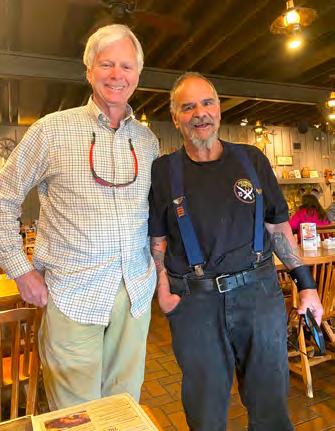
“Everything happens for a reason,” he told me. In mere minutes, Sergeant Longo and I became fast friends as often happens between veterans. Sergeant Longo is a former special ops soldier who served about two
and a half decades in various wars and capacities dating back to Vietnam. He later texted me: All gave some. Some gave all. (Our meeting preceded Memorial Day by forty-eight hours.) He shared a photo with me of one of his three motorcycles—an Indian with a black POWMIA flag flying from it. The sleek machine has transported him all over the country on Veterans’ rides. He confessed he’s done a lot of bad things “back in the day,” but that HIS grace is sufficient for him. As you read this, rest assured, Sergeant Longo is out there somewhere, probably on one of his bikes, witnessing the love of Jesus.
Nothing is more fun and exciting to me on these trips than the serendipity of meeting great Americans like Johnny Longo. America is not only a beautiful
land of freedom; it’s a land of beautiful and courageous people in myriad profiles and colors. Sustained national revival is a blessing we desperately need. Lord, help us wake up.
(If) my people who are called by My name humble themselves and pray, and seek My face and turn from their wicked ways, then I will hear from heaven, will forgive their sin, and will heal their land. 2nd Chronicles 7:14: (NAS).

Barganier is a novelist, travel writer and speaker. He travels far and wide upon the slightest excuse for something interesting to write about. His novels include Lawson’s Bluff (2021); The Slash Brokers (1998). He also manages Cindy Barganier Interiors LLC (www.cindybarganier.com) at The Waters in Pike Road, Alabama. Contact Jeff at Jeffbarganier@knology.net. You may print out his features at www.jeffbarganier.com and take them with you when you travel!




If you are like me, you are up for brunch any time of the year, not just for special occasions. The best part about brunch, other than the food of course, is that the timing of brunch allows you to schedule a midday event that won’t conflict with other obligations.
1. Bagel Bar – Experiment with different flavored bagels and cream cheese.
2. Toast it! – Include all the popular toasts - avocado, French, cinnamon, peanut butter, and champagne.
3. International Brunch – Everyone brings a dish from another country.
4. Scrumptious Salads Brunch – Hot or cold, green or pasta. Any salads are welcome.
5. Tea Party Brunch – Offer finger sandwiches and a variety of teas.
Brunch essentially opens another time slot in your busy schedule for socializing. Imagine how much fun it would be to start a brunch club that met once a month so you could catch up with friends and try new recipes. Not sure how to do it? Check out some of these ideas we came up with.
6. Campout Brunch – Dine around the fire with all your favorite foil meals.
7. Potato Bar – Baked potatoes (russet or sweet) and all the toppings.
8. Taco Bar – Wraps or rice make great vehicles for all your taco favorites.
9. ABC Brunch – Bring something with a specific letter or your first initial.
10. Pasta Bar – Great creative with different noodles, sauces and cheese.
Start by gathering your group. Will your brunch include your neighbors, former workmates or college friends? Be sure
everyone that participates is willing to host. Choose how often you will meet, what day of the week works best and if the event will be potluck or host supplied. Pick a few themes to start with or let the hostess come up with her own. Here are a few to get you started:
Charcuterie Board Brunch –Everyone brings a charcuterie board to share. There are dozens of ideas beyond the usual cheese, sausages and crackers. Try a breakfast board with mini waffles and a variety of toppings. Other board ideas include a fruit board, veggie board, dessert board, cracker and spread board, nacho board or a soup, yogurt or smoothie shooter board.

Pretty in Pink – Another fun idea is a color theme and pink is an easy one. There are dozens of pink foods and cocktails that you can create for this brunch. In addition, you can color foods by adding beets, strawberries or a little red food coloring. Fun pink drinks include cosmopolitan martinis or a glass of Rose. This pink theme would be perfect for after a Relay for Life event supporting Breast Cancer Awareness.
Bite Sized and Board Games – This brunch theme would include one (or two) bite items like deviled eggs, wonton cups, mini meatballs, toothpick kabobs, mini pinwheels, sweet pepper poppers, mini bruschetta and cucumber bites. Pass out shot glass sized flights of wine, cocktails or flavored coffees. Fill your plates and set up your favorite board games like The Chameleon, Telestrations or Hedbanz.

Ponytails and Pajamas Brunch – Sometimes after a long week, you don’t have the energy to get dressed up and make a dish to bring to a party. For this brunch theme, throw on comfy pajamas, put your hair in a ponytail and bring a store bought brunch item. Easy ideas include croissants, salads, bagels and cream cheese and ready made deli trays like cold cuts or veggies and dip.
Muffins and Mimosas – There are so many things you can make in a muffin tin, so get creative with this brunch theme. In addition to fruit flavored muffins, our muffin tin favorites are eggs, mini meatloaf, cornbread, pizza bombs, oatmeal cups, taco cups and mini lasagnas just to name a few. Don’t forget about cupcakes for dessert. Offer flights of mimosas made with different juices like orange, grapefruit, mango, pomegranate, peach, cranberry or pineapple.
Childhood Feast Brunch – We all have childhood favorites that we would rather not admit to enjoying. In this eclectic brunch theme, you can share them guilt-free with your friends. Guests can bring their favorite sugary cereal, tater tot casseroles, sloppy joes, grilled cheese, egg salad, fluffernutter sandwiches, puppy chow or Jell-O. Offer guests a milkshake bar with fun add ins like M&Ms and Oreo cookies.
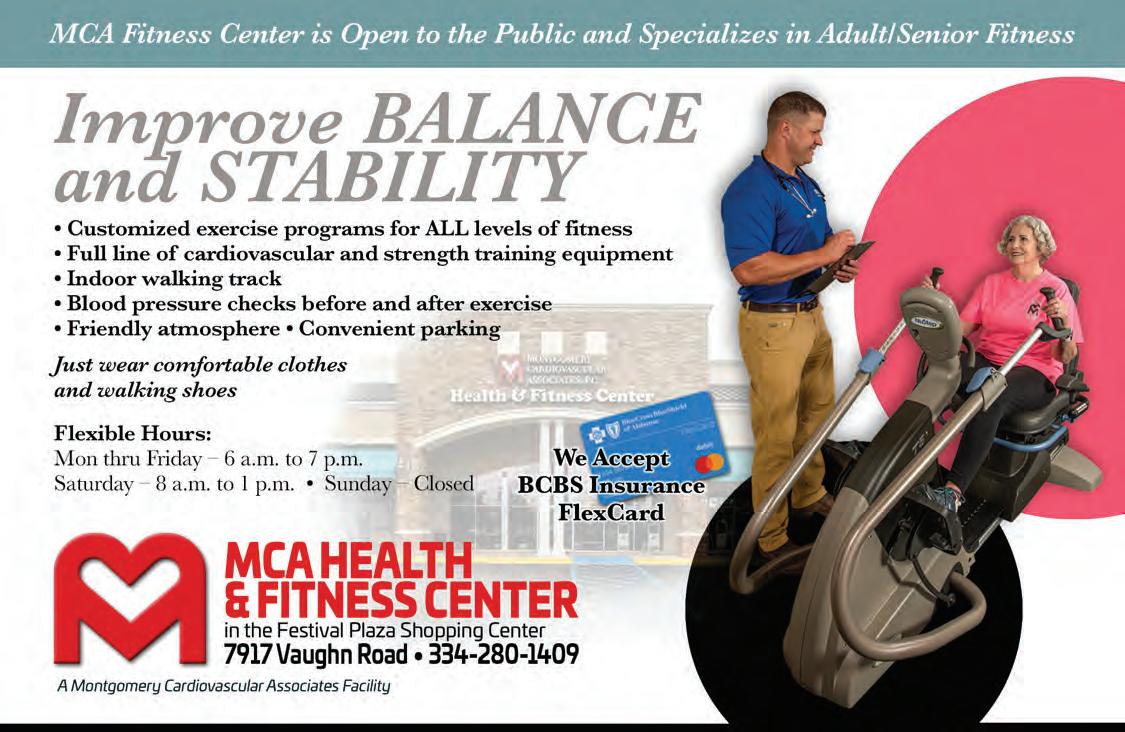




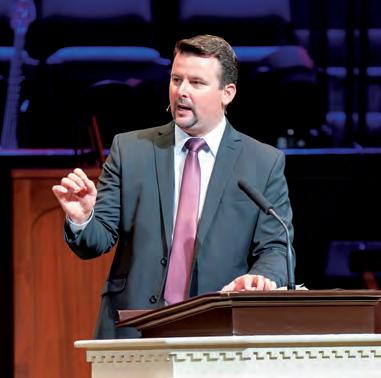
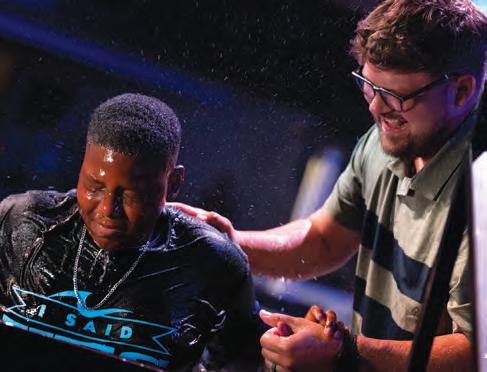
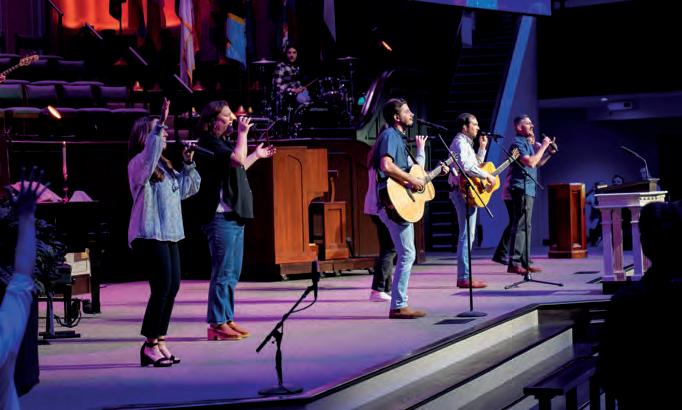
By Greg
I recently asked Siri to give me the word for "250th Anniversary".
For the first time, I heard her say, "I don't know!"
Quarter-millenia? We have a year to figure it out.
We all remember the BiCentnnial.
In 1976, America threw itself a 200th birthday party so gaudy, patriotic, and gloriously over-the-top that it's still seared into the memory like a sparkler burn on a picnic table. We celebrated it. We wore it. The Bicentennial wasn't just a historical milestone; it was a cultural juggernaut that swept up everyone from disco dancers to suburban moms, uniting the nation in a fever dream of red, white, and blue. Let's look back at the starspangled extravaganza and its lasting, sometimes cringe-worthy, impacts. Like Bi-centennial jeans? Shoes? Shirts. Red, white, and blue trim on houses. I saw it! I had a pair of the jeans, too.
when you could get one emblazoned with "1776-1976"?
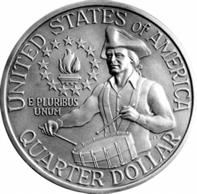
The cultural impact was immediate and relentless. Fashion took a hard turn into Revolutionary chic. Men sported tricorn hats unironically, while women donned colonial-style dresses that screamed "Martha Washington, but make it polyester." Kids weren't spared either—Bicentennialthemed lunchboxes featuring minutemen and Liberty Bells were the must-have playground accessory. Even pets got in on the action, with dog collars and cat beds festooned with stars and stripes. The nation was drowning in kitsch, and it loved every second of it. Our family's wiener dog wore a red, white, and blue tube sweater!
shaped like the Liberty Bell, reenactors in wool uniforms sweating through musket drills, and kids waving sparklers like they were conducting a patriotic orchestra.
In Washington, D.C., the festivities were next-level. Operation Sail brought tall ships from around the world to New York Harbor, a majestic nod to America's seafaring past. Fireworks lit up the sky in displays so extravagant they made modern Fourths look like backyard bottle rockets. President Gerald Ford, not exactly a charisma machine, gave speeches that tried to rally a nation still licking its wounds from Vietnam and Watergate. For one day, at least, the country seemed to agree: America was pretty darn cool.
The buildup to July 4, 1976, was like watching a nation chug a gallon of patriotic Kool-Aid. For years, the American Revolution Bicentennial Administration (yes, that was a real thing) orchestrated a campaign to make sure no American could escape the festivities. Cities, towns, and even the tiniest hamlets were decked out in bunting, flags, and enough eagle imagery to make a bald eagle blush. The official logo—a star wrapped in a ribbon of red, white, and blue—was slapped on everything: T-shirts, mugs, keychains, even toilet paper for the truly devoted. Consumerism and patriotism had never been so gloriously intertwined. Why buy a plain toaster

Music, too, caught the Bicentennial bug. While disco ruled the airwaves, patriotic anthems sneaked into the mix. Johnny Cash, ever the American icon, released albums dripping with frontier spirit, and school choirs belted out "Sweet Land of Liberty" and "Nifty 50" with the fervor of tiny revolutionaries. Meanwhile, advertisers leaned hard into the theme. McDonald's rolled out Bicentennial glasses featuring George Washington and Ben Franklin because nothing says "freedom" like a Big Mac and a collectible tumbler. Jingles about liberty and unity blared from every TV and radio, embedding themselves in brains alongside ABBA's "Dancing Queen."

But the Bicentennial wasn't just a one-day blowout; it left a cultural footprint that's still visible if you squint. For one, it sparked a renewed interest in American history. Museums saw record visitors, and historical societies flourished as people dug into their roots. Shows like Roots, which aired in 1977, owed part of their success to the Bicentennial's push to explore the American story—warts and all. Genealogy became a national pastime, with families tracing their lineage back to Revolutionary soldiers or, in some cases, just making it up for clout at the local VFW.
The main event, of course, was July 4 itself. Across the country, communities went all out. Parades featured floats
It also cemented the Fourth of July as America's ultimate party day. Before '76, Independence Day was big, but not this big. The Bicentennial turned it into a cultural juggernaut, complete with branded merchandise and over-thetop displays of national pride. Today's backyard BBQs, flag-themed bikinis, and monster-truck-sized fireworks owe a debt
to that summer when America went all in on itself.
Yet, not everything about the Bicentennial aged well. The unrelenting patriotism could feel forced, especially for those grappling with America's less rosy realities—no county is historically wartless. Some critics called it a distraction, a way to paper over division with flags and fanfare. And let's be honest: the sheer volume of tacky souvenirs was a crime against taste.
Those Bicentennial plates gathering dust in thrift stores? They're the ghosts of '76, haunting us with their earnest excess.

In the end, the Bicentennial was America at its most gloriously absurd—a nation that could celebrate its past while disco-dancing into an uncertain future. It was a moment of unity, however fleeting, in a decade of fracture and malaise. Its cultural impacts linger in our love of spectacle, our obsession with history (real or mythologized), and our unshakeable belief that everything's better with a flag on it (because it is!).
So here's to 1976: the year America threw a party so big that we're still finding confetti in our cultural couch cushions. And here's to 2026! With President Trump, the celebration could make '76 look like a kid's birthday party. I hope it does. When you think about it, BOOMers are lucky to have a shot at two huge national birthday parties.
Or, as the Founders called it- the Original No Kings Day.

Greg Budell has lived in Montgomery for 20 years. A 50+ year veteran of radio, TV and writing, Greg hosts the Newstalk 93.1FM Morning Show with Rich Thomas, Susan Woody, and Jay Scott, 6-9 AM Monday - Friday. He returns weekday afternoons from 3-6 PM for Happy Hour with Pamela Dubuque and a variety of sidekicks. His favorite topic is life! Greg can be reached at gregbudell@aol.com.



If you've been hearing the buzz about pickleball and wondering what all the excitement is about, you're not alone. From neighborhood courts to recreation centers, this paddle sport is sweeping the country—and it's especially popular among adults 50 and older. Whether you're looking to stay active, meet new friends, or just try something new, pickleball might be your perfect match.
Pickleball has seen explosive growth in the last few years. According to the Sports & Fitness Industry Association, it's now the fastest-growing sport in the U.S. for the third year in a row, with more than 36.5 million players nationwide as of 2023. So what's driving the boom?
It's easy to learn. Unlike tennis or golf, which can take years to master, pickleball is beginner-friendly. Most players can pick it up within an hour.
It's social. Games are often played in doubles, meaning you're always paired up and interacting.
It's low-impact but high fun. The court is smaller than a tennis court, so you don't have to run as much—but you still get plenty of movement. It's affordable. All you need is a paddle, a ball, and access to a court.

Many local players connect through Facebook groups, such as "River Region Pickleball Club" or "Prattville Pickleball." These pages are a great place to ask about beginner lessons, meet-ups, or court availability. Also, visit https://pickleballmontgomery. com and ymcamontgomery.org for more opportunities in the area.
From retirees and fitness newbies to former athletes and weekend warriors, players of all skill levels are discovering just how addictive this game can be.
Pickleball is a blend of tennis, badminton, and ping-pong. It's played on a small court with a paddle and a perforated plastic ball. Here's a quick breakdown:
Players: You can play singles or doubles (doubles is more common and less physically demanding).
Serve: The serve must be underhand and made diagonally, landing in the opponent's service box.
Scoring: Games are played to 11 points, but you must win by 2. Only the serving team can score.
The Kitchen: No-volley zone near the net. You can't hit a ball in the air while standing in this area. This rule encourages more thoughtful, controlled play rather than aggressive slams.
Most games last around 15–20 minutes, making it easy to play multiple matches in a single session.
* Adults over 50 looking to stay active without stressing their joints
* Couples or friends wanting a new hobby together
* People recovering from injuries who need low-impact movement
* Tennis or racquetball players who miss the game but need something gentler
* Anyone craving social connection and community
Don't worry if you haven't played a sport in years. The welcoming atmosphere of most pickleball groups makes it easy to jump in, no matter your athletic background.
Pickleball isn't just about hitting a ball—it's a holistic wellness boost wrapped in a good time.


Physical Health: Improves balance and coordination, Burns calories and supports cardiovascular health, Builds leg and core strength, Promotes flexibility and joint mobility. Because it's low-impact, pickleball is especially great for people with arthritis, joint replacements, or back pain who still want to stay moving.
Mental and Emotional Health: Boosts mood and reduces stress through regular physical activity; Improves mental sharpness thanks to quick decisionmaking and hand-eye coordination; Fights loneliness—playing with others fosters connection and friendships; Many players say the biggest benefit isn't even physical—it's the friendships they've formed and the sense of community that keeps them coming back.
1. Show up. You don't need to know anyone—most groups are very welcoming and happy to teach newcomers.
2. Wear comfortable shoes. Court or tennis shoes with good lateral support are ideal.
3. Bring water and a smile. Most games are short and fast-paced, and it's easy to rotate in.
4. Start slow. Don't feel like you need to master it on day one. Just have fun and keep showing up.
5. Join a group. Many local players connect through Facebook groups, such as "River Regioin Pickleball Club" or "Prattville Pickleball ." These pages are a great place to ask about beginner lessons, meet-ups, or court availability. Also, visit https://pickleballmontgomery. com and ymcamontgomery.org for more opportunities in the area.
Final Word: Don't Just Watch—Play!
Whether you're looking to stay fit, build new friendships, or find a hobby that makes you laugh out loud, pickleball delivers. So grab a paddle, head to a court, and see what the hype is all about.
Your new favorite sport is waiting. •


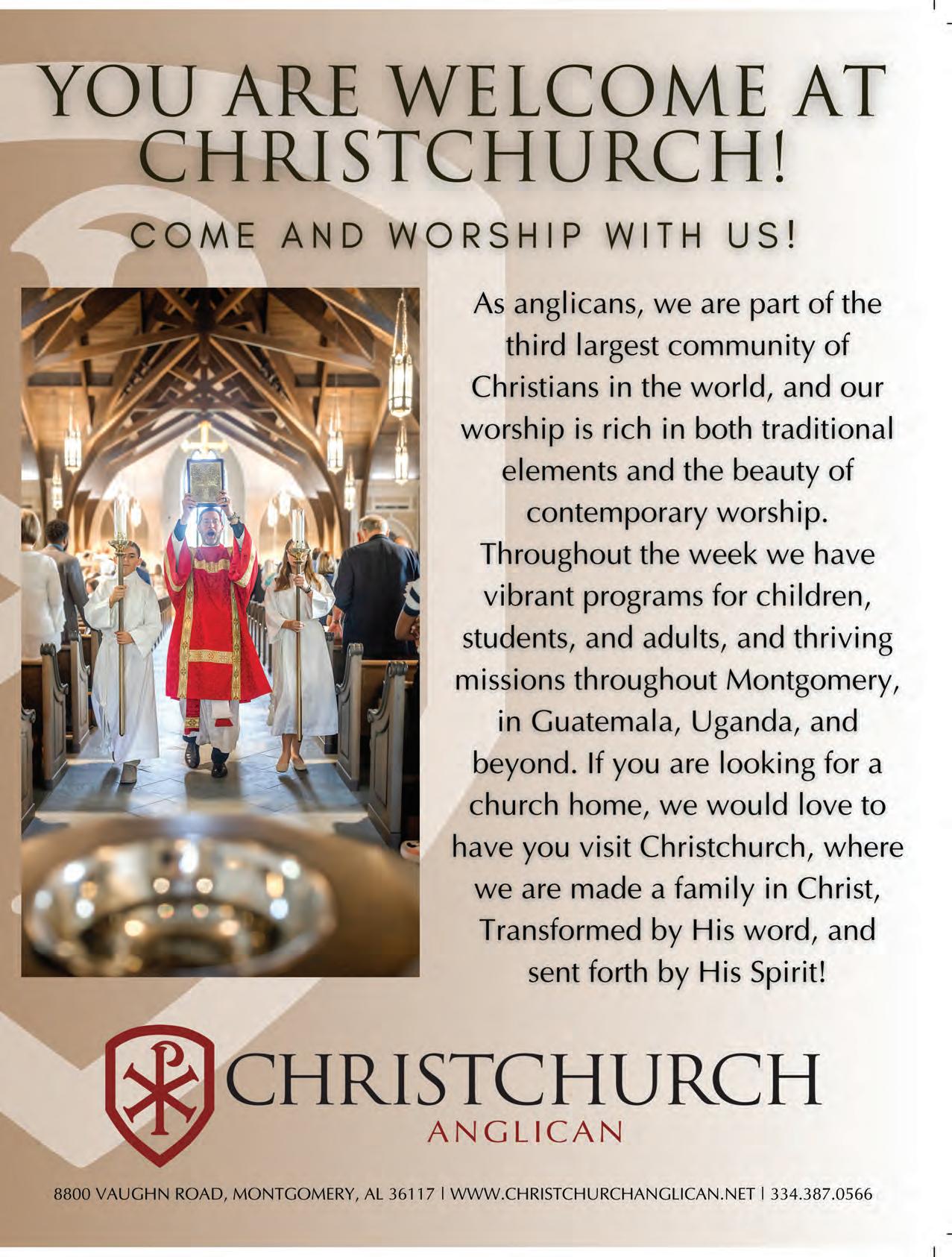



As women enter their mid-50s and beyond, conversations around bone health tend to grow louder—and for good reason. You've probably heard about osteoporosis, maybe even had a friend who broke a bone from what seemed like a minor fall, or been told to get a bone density scan. But is bone density loss just another “aging myth” or a very real health issue facing women in this stage of life?
The answer is: it’s very real. And the good news? There’s a lot you can do about it.
Your bones are not just a rigid framework holding your body together. They’re dynamic, living tissues that continuously break down and rebuild themselves. Up until your early 30s, bone production generally keeps pace with breakdown. But after that, particularly around menopause, that balance starts to shift. Estrogen—a hormone that helps maintain bone density—drops dramatically during menopause, which can accelerate bone loss.
For women over 55, this loss can be significant. In fact, according to the National Osteoporosis Foundation, up to 20% of a woman’s bone density can be lost in the first five to seven years after menopause.
Bone density loss often goes unnoticed until a fracture occurs. Common fracture sites include the hips, spine, and wrists. But the consequences go far beyond a cast and some rest. Hip fractures in older adults are associated with a serious decline in mobility, independence, and even life expectancy.

So yes—bone loss is real. But it’s not inevitable, and it’s definitely not untreatable.
A bone density test, also known as a DEXA scan, is a painless and non-invasive test that measures the amount of bone mineral in certain parts of your skeleton, usually your spine and hips. It provides a T-score:
Above -1.0 is considered normal.
Between -1.0 and -2.5 indicates osteopenia (low bone mass). Below -2.5 signals osteoporosis.
Most women are recommended to get their first DEXA scan at age 65. However, if you have risk factors—such as a family history of osteoporosis, early menopause, long-term steroid use, or a low body weight—you should talk to your doctor about testing earlier.
While aging is a natural contributor to bone loss, several other factors increase risk:
• Lack of weight-bearing exercise
• Calcium and vitamin D deficiency
• Smoking or excessive alcohol use
• Certain medications (like steroids or anticonvulsants)
• Digestive disorders (e.g., celiac, IBS, Crohn’s)
• Sedentary lifestyle
Discover the benefits of our all-in-one Blue Advantage® (PPO) plans, designed to ensure you get the care you need while keeping your costs low. With Blue Cross and Blue Shield of Alabama, you’ll enjoy:
• A partner dedicated to providing an easy healthcare experience — in 2024, our Blue Advantage plans received 5 stars for Health Plan Customer Service and 4 stars for Overall Star Rating1.
• Access to 90% of doctors and 100% of hospitals statewide1
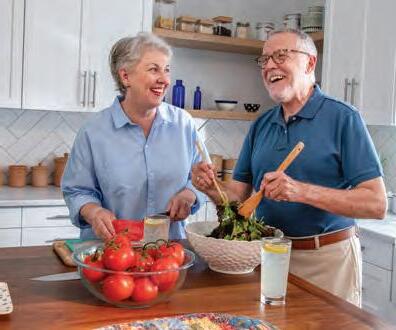
Combatting Bone Loss: A Plan of Action
Thankfully, there are many evidence-based strategies to strengthen your bones and reduce your risk of fractures.
1. Load-Bearing and Strength Training: Weight-bearing exercise is critical for bone health. That doesn’t mean you need to run marathons or lift like a bodybuilder. Instead, think of activities that work against gravity:
• Walking briskly
• Dancing
• Hiking
• Tennis or pickleball
• Tai chi (which also improves balance!)

Strength training—using resistance bands, dumbbells, or even your body weight—helps stimulate bone-building and supports muscle strength, which reduces fall risk. Try to incorporate strength training 2–3 times a week and weight-bearing activities daily if possible.
2. Calcium: More Than Just Milk - Your body needs calcium to build and maintain strong bones, but it can’t produce it on its own. Women over 50 should aim for 1,200 mg of calcium per day. Great food sources include:
• Dairy products (yogurt, milk, cheese)
• Leafy greens (collards, kale, bok choy)
• Fortified foods (orange juice, plant-based milks)
• Sardines or canned salmon with bones

If you're not getting enough from food, supplements can help— but it’s important not to go overboard. Too much calcium (especially in supplement form) can increase the risk of kidney stones and possibly heart issues. Always consult your doctor before starting supplements.
3. Don’t Forget Vitamin D: Vitamin D helps your body absorb calcium. Without it, even high calcium intake won't do much good.
Women over 50 need 800–1,000 IU per day. You can get it from:
• Sunlight exposure (15–20 minutes a day)
• Fatty fish (salmon, mackerel, tuna)
• Egg yolks
• Fortified foods and supplements
5. Medications When Needed: For some women, lifestyle changes may not be enough to slow or stop bone loss. Several prescription medications can help prevent fractures by either slowing bone breakdown or helping rebuild bone.
These include: Bisphosphonates (e.g., Fosamax, Reclast), Selective estrogen receptor modulators (SERMs), Hormone therapy, Parathyroid hormone analogs (e.g., Forteo).
Talk with your doctor about your personal risk and whether medication is right for you.
Fall Prevention: The Overlooked Strategy
Even strong bones can break from a hard fall. That’s why fall prevention is a cornerstone of bone health—especially in women over 55.
Tips to reduce fall risk:
• Use nightlights and remove tripping hazards at home.
• Install grab bars in the bathroom and stair rails where needed.
• Get your vision and hearing checked regularly.
• Wear well-fitting, non-slip shoes.
• Stay active to maintain coordination and balance.
Balance-focused activities like yoga and tai chi are particularly helpful.
Aging doesn’t mean fragility—it means adaptation. While bone loss is a real concern, it’s far from a death sentence for your strength, mobility, or independence.
By staying active, nourishing your body, getting screened, and making small, sustainable lifestyle changes, you can keep your bones strong well into your 70s, 80s, and beyond.

Remember: it's never too early—or too late—to start taking care of your bones. Think of it as a long-term investment in freedom, vitality, and confidence.
Bonus Tip: If you haven’t had your bone density checked yet, ask your doctor about scheduling a DEXA scan. Knowledge is power, and your future self will thank you for it. •






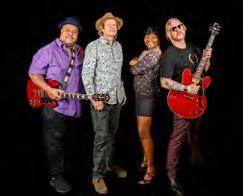
Sunday, August 10 at 7:30 pm
Join us for an unforgettable night of soul-stirring music at the Devon Allman Blues Summit, a powerhouse gathering of blues legends that promises to electrify the stage. Featuring Devon Allman at the helm, this summit brings together an all-star lineup that includes the legendary Jimmy Hall of Wet Willie and Jeff Beck fame, who is renowned for his fiery harmonica and powerful vocals. Added to this magical evening is blues icon Larry McCray who is known for masterful guitar work and heartfelt stories that have resonated with fans worldwide. Complementing the summit’s line up is New Orleans’ very own soul sensation, Sierra Green, whose enchanting voice encapsulates the heart and spirit of the Crescent City. Together, this remarkable assembly of artists presents an epic evening that spans the spectrum of blues – from its gritty roots, through its evolution, and into its vibrant future. Tickets are $25-$55. Visit mpaconline.org.
Mount Vernon Performing Arts Center, 321 Barnett Blvd, Tallassee
Why settle for just any tribute show when you can experience the ultimate Elvis experience with Kenneth Loomis and friends!?! Join us for a night that will leave you singing along to the King's greatest hits and dancing in the aisles. Don't miss out on this unforgettable tribute to the one and only Elvis Presley! Visit https://mtvernonpac.ticketspice.com/elvis for tickets.
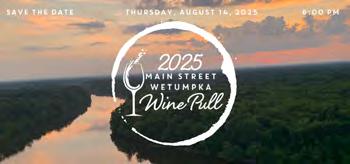

Main Street Wetumpka's signature Wine Pull event is BACK for the fifth year, thanks to our friends at Wind Creek Casino & Hotel! The evening will offer stunning penthouse views, accompanied by splendid food and wine pairings from the award-winning Fire Steakhouse. Each pair of attendees will “pull” a bottle of wine and receive two signature wine glasses. Proceeds from this event go directly towards Main Street Wetumpka's mission of downtown revitalization. Members: Couple $120 & Single $75 (Subject to taxes & fees) Non-Member: Couple $150 & Single $85 (Subject to taxes & fees) Visit https://www.bigtickets.com/e/main-street-wetumpka/winepull2025/.
Please present coupon or mention you saw it in the BOOM! Digital Issue. Offer Expires 07/31/25 Receive an




Prattville’s Creekwalk Concerts on Tuesdays 6:30 pm * July 8 and 22 * Pratt Park
Military Appreciation Night, July 8, with Taylor Bagi. July 22: For Heavens Sake. Attendees encouraged to bring blankets or chairs, and friends to share the memories! Featured food vendors each week! This is a family-friendly event! Visit https://prattvilleal.gov/.
Jaylen Wilson has been with Home Care Assistance since April 2025. In this short time she has displayed exceptional compassion, grace, kindness and genuine care for each and every one of her clients. HCA is honored to have her as part of our team!
you, Jaylen, for being so
For more information visit www.homecareassistancemontgomery.com.

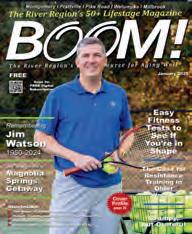
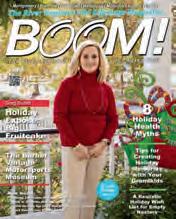



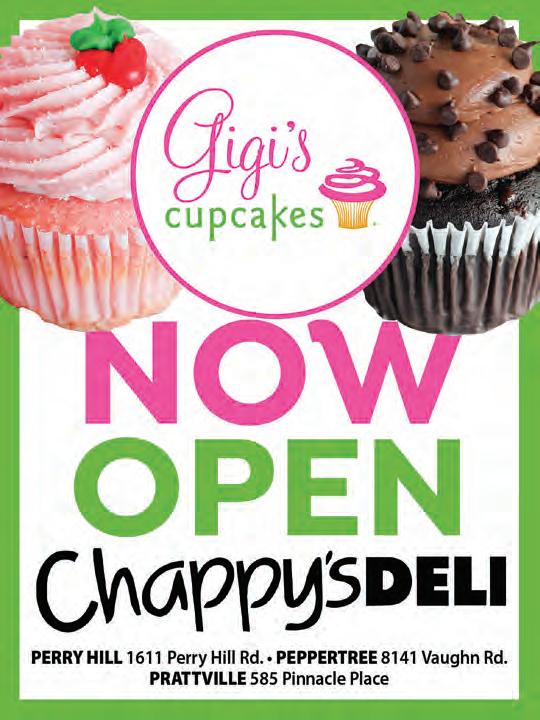

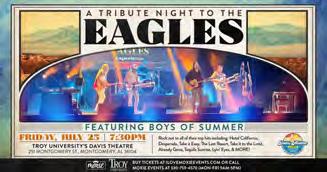
July 25 * 7:30 pm * Troy University’s Davis Theatre
Boys Of Summer Eagles Experience! All the greatest hits like One Of These Nights, Witchy Woman, Best Of My Love, Take It To The Limit, Life In The Fastlane, Hotel California, Desperado, Take It Easy, Peaceful Easy Feeling, Tequila Sunrise, New Kid In Town, Already Gone, Victim Of Love, plus so many deep cuts from the 70s! Tickets at www.ilovemoxieevents.com.
August 9 * 7 am
We are bringing together local vendors to spotlight all of their merchandise, lotions, gifts, and more.
Vendor spaces are 10x10 for $25 and 20X10 for $45 by reservation only. Also, enjoy Food Trucks, Bounce Houses, Character Actors, and Entertainment. General Admission is $5 per person or a can of food for the Heart of Montgomery Food Bank or a pet food for our Montgomery Humane Society. 100% family friendly event. Visit https://thegarrettcoliseum.com/may-9-2025-rhythm-blues-2/.
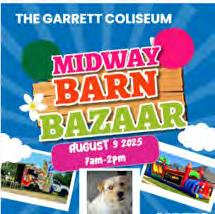

July
The Capital City Golf Classic features multiple flights, a professionally run format, and great prizes. -Championship Flight: 54 holes (3 days) -Other Flights & Senior Division (60+): 36 holes (2 days) -Verifiable Handicap Index required -Ages 16+ eligible Registration Deadline: July 15 at 5:30 PM at PlayMontgomeryGolf.com.
This GriefShare group is offered for anyone who has lost a loved one. We use the new GriefShare 4.0 video-based curriculum followed by discussion concerning the stages of grief, the storms that come with it, and ways of dealing with loss. Frazer Church-East Sanctuary, 6000 Atlanta Hwy, 10:00 AM–12:00 PM, Weekly on Wednesday CONTACT: BJ Nave rnave@frazer.church 334.495.6343

or


The Alabama Senior Citizens Hall of Fame has honored and recognized Alabamians aged 60 or older for their outstanding contribution to the lives of older members in their local communities since 1983. Those selected as Permanent Members of the Hall of Fame are formally honored and recognized for their selfless advocacy and dedication of service to others at an official ceremony held in Montgomery each year. The Alabama Senior Citizens Hall of Fame also recognizes Alabama seniors who are 100 years or older and couples married 65 years or more.
Event held at Montgomery Marriot Prattville Conference Center at Capitol Hill, Prattville, Alabama.
Our curated lineup features high-profile features, global shorts, and local films, along with retrospective screenings and cult classics. As central Alabama's cinematic hub, we bring together audiences and filmmakers to celebrate independent film. Join us for a diverse showcase of storytelling and creativity, exploring the world of cinema right here in Montgomery. Visit https://montgomeryfilmfestival.com/ for all the details and follow Capri Theatre on Facebook for updates!

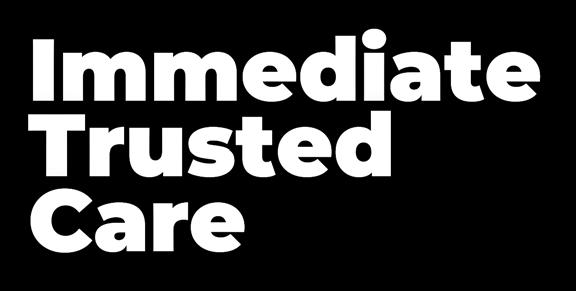





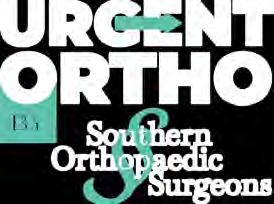
With 175 state parks spread across the Sunshine State, the Florida State Park system is one of the largest in the U.S., providing visitors with the opportunity to explore a range of diverse environments. If you're looking for parks with jawdropping crystal-clear water, it's hard to surpass Rainbow Springs State Park.
Located just a few miles north of Dunnellon in Marion County, northcentral Florida, Rainbow Springs releases millions of gallons of freshwater into the 1,470-acre park daily. With such a large volume of water rushing from the springs, you might expect a raging river to emerge. But the water enters through numerous small springs to create the gently flowing 5.7-mile Rainbow River that eventually joins the Withlacoochee River downstream.

that is. In the late 1800s, the discovery of phosphate rock in the area sparked a mining boom for this valuable mineral used in fertilizers. The soil dredged from the phosphate pits was piled into mounds and later transformed into water features like Seminole Falls.
can be seen gliding through the water. The park is especially beautiful in the spring when dazzling azaleas bloom.
Originally known as Blue Spring, the park was renamed in the 1930s to attract tourists. Once privately owned and featuring a small zoo, it closed in the 1970s but reopened as a State Park in 1995 after extensive cleanup.
"There are nearly 87 spring vents throughout the entire headsprings area and down the run approximately 1.5 – 2 miles," Bobbie Lakhani, Administrative Assistant at the park, told me. "Since they are spread out down the river, this helps keep the water flow at a minimal speed of about 1 to 1.5 miles per hour."
Begin exploring the park on foot via the waterfall trail, which feels like stepping into a tropical paradise. The paved path is just past the visitor's center and winds through lush ornamental gardens, where three artificial waterfalls cascade into various babbling streamlets.
The path features some inclines and a few steps, but shaded gardens beneath a canopy of towering oaks and magnolias, accompanied by the soothing sound of flowing water, create a peaceful and relaxing environment – when not crowded,
Along with the other two park waterfalls, Rainbow and Aviary Falls, the three are fed by recirculated river water. Park officials can control the water flow, so
The park is renowned for its striking blue-green, crystal-clear water that remains a pleasant 72 degrees year-round. This makes it a popular spot for swimmers during the summer and especially on weekends. According to the park's website, it may even close "when (it) reaches capacity at the headsprings entrance," which it may do soon after opening – so arrive early. When we visited in mid-spring, it was busy but not overcrowded, although we did have to stand in line for about 10 minutes to pay the entry fee ($5 per vehicle). The deep, inviting blue waters were certainly tempting, but we chose to explore the park on foot rather than swim.

there could be days during maintenance when the waterfalls are turned off. Several boardwalks also provide visitors with stunning views of the swimming area and Rainbow River, where canoes and kayaks
Beyond the waterfall path, a 2.5-mile nature trail provides views of the river and phosphate pits and winds past the crumbling remains of the former zoo – a poignant reminder of the harsh conditions once endured by captive animals. But the level hiking path is ideal for those seeking to burn a few extra calories in one of Florida's most unique parks.
Nick Thomas teaches at Auburn University at Montgomery in Alabama and has written features, columns, and interviews for many newspapers and magazines. His hiking column describes short trails, hikes, and walks from around the country that seniors might enjoy while traveling. See www.ItsAWonderfulHike.com.
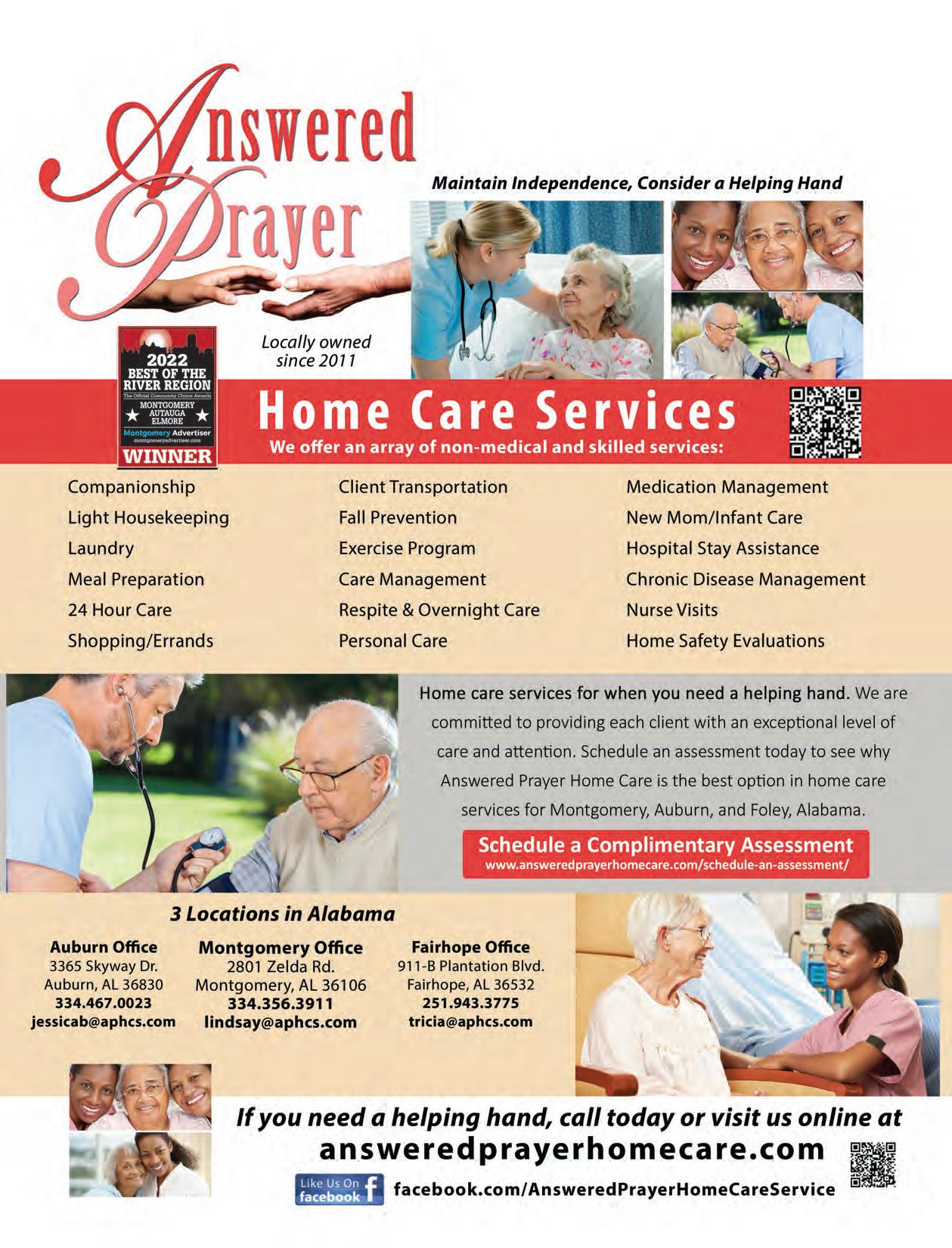





Visiting the doctor can sometimes feel overwhelming, especially when dealing with complex medical concerns or unfamiliar terminology. As we age, it becomes even more important to take an active role in our healthcare to ensure we receive the best possible treatment.
Advocating for yourself at doctor’s appointments is about being prepared, asking the right questions, and making sure your concerns are heard.
Here’s how you can take control of your health and make the most of your medical visits.
A productive doctor’s visit starts before you even step into the office. Take some time to write down any symptoms, changes in health, or specific concerns you want to discuss. Keeping a health journal or list of questions can help you remember important details. If you’re seeing a new doctor, bring a summary of your medical history, including medications, previous diagnoses, and any recent test results. Having this information readily available allows for a more efficient and thorough discussion.
If you feel nervous about remembering all the details or advocating for yourself, consider bringing a trusted friend or family member. A second set of ears can help catch important information, ask additional questions, and provide support. Having someone else present can also help ensure that you fully understand your doctor’s recommendations and treatment plan.
Doctors often have limited time, so it’s essential to make your concerns clear and ask specific questions. Don’t be afraid to ask for clarification if something

is unclear. Questions like, “What are the potential side effects of this medication?” or “Are there alternative treatment options?” can help you make informed decisions. Taking notes during the appointment ensures you have accurate information to refer back to later.
You can always ask the doctor to write things down for you as well. This ensures that you are getting the information that you need when you go home. Another idea is to use your phone to record the doctor’s recommendations (with the doctor’s permission.)
Your healthcare should be a collaboration between you and your doctor. If a prescribed treatment doesn’t align with your lifestyle or if you have concerns about a medication’s side effects, voice those concerns. Doctors appreciate engaged patients who actively participate in their care. If you feel your doctor isn’t addressing your concerns, don’t hesitate to seek a second opinion.
Medical expenses can add up quickly, so it’s important to understand your insurance coverage and potential outof-pocket costs. Ask your doctor or their office staff about generic medication options, alternative treatments, or financial assistance programs if needed. Being informed about costs can help prevent unexpected medical bills and

ensure you receive the necessary care without financial stress.
Advocating for yourself doesn’t end when the appointment is over. Follow up on test results, referrals, or

prescribed treatments. Keep a folder or digital record of your medical history, medications, and doctor’s notes so you can track your progress and maintain an accurate health record. If you don’t hear back about test results, don’t assume everything is fine—call the office and ask for an update.
A strong doctor-patient relationship is built on trust and communication. Be honest about your symptoms, lifestyle habits, and any concerns you may have. A doctor who knows and understands you is better equipped to provide personalized care. If you feel your doctor isn’t listening to you or respecting your input, consider switching to a provider who makes you feel heard and valued.
Advocating for yourself at doctor’s appointments is one of the most powerful ways to take control of your health. By preparing in advance, asking questions, speaking up about your concerns, and staying organized, you can ensure you receive the best care possible. Your health is too important to leave to chance—take an active role and make your voice heard. •
Rebecca Hastings is a freelance writer and frequent contributor.

“Advertise



In this inspiring and heartfelt interview, Tonya and Butch Speed—married 41 years—reflect on the deep lessons learned through decades of love, faith, creativity, and commitment. They share how marriage has grown from youthful romance into a daily choice to show up for one another, especially during life’s harder moments, including Butch’s ongoing journey with Parkinson’s. Tonya’s beloved dance studio has become a multi-generational haven where confidence and character are built, while Butch’s artwork and mentoring at Success Unlimited Academy continue to inspire young people. Together, they model what it means to age with purpose—choosing joy, leaning on faith, and embracing the beauty of each new season, hand in hand.
BOOM: Congratulations on 41 years of marriage! What's one thing each of you has learned about love, trust, or partnership that you didn't know when you first said "I do"?
After 41 years of marriage, one thing we've both come to understand is that love is more than a feeling—it's a daily choice to stay committed, especially when life has ups and downs. There have been times when one of us had to give a little more, carry more, or be the steady one, but staying fully committed to each other has built a deep trust and bond that holds us together.

We've learned the value of listening well, speaking kindly, and knowing when to meet in the middle. Lastly, partnership is about growing together while giving each other space to be who we are individually, and it's okay to be different, to have our own strengths, and still be moving forward in the same direction. We have become teammates for life!
BOOM: You've both built lives that center around creativity and influence.
How would you describe the intersection of your marriage and your creative passions?
Tonya: Our journey of creativity and influence began when we were just 15, newly dating and serving side-by-side in Vacation Bible School. Butch led crafts with his artistic touch, and I shared music during group time. Looking back, that early collaboration was a clear
glimpse of God's greater plan for our lives together.
Throughout high school and college, we each pursued our own creative paths—Butch in choral performance and visual arts, and I in piano, flute, and dance. Yet even as our talents developed individually, our support for one another remained constant. That creative connection became a steady rhythm in our relationship and ultimately laid the foundation for opening the dance studio in 1986.
Over the years, we've partnered in countless projects—from the Montgomery County Junior Miss Program and church productions like the Living Christmas Tree to high school
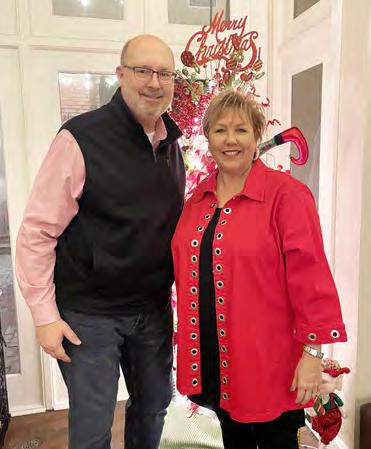

and college musicals and children's events. But the heart of it all hasn't been applause or accolades—it's been about living a life of purpose, rooted in faith and a shared desire to use our gifts to serve and inspire. By dreaming, creating, and encouraging one another, our marriage has grown stronger with each season— bringing joy, meaning, and a deeper appreciation for the journey we've shared.
BOOM: Tonya, your dance studio has been a fixture in this community for nearly four decades. What keeps you inspired after all these years, and how has your role evolved?
Tonya: What keeps me inspired, even after all these years, are the students. Watching a child walk into the studio shy and unsure, then blossom into a confident, expressive dancer—that never gets old! Each generation brings something new: fresh energy, different stories, and their own unique spark and excitement. They keep me growing, too.
As for how my role has evolved, I've gone from being the hands-on teacher in every class to being more of
a mentor and visionary. I still love teaching, but now I also find joy in collaborating with my teachers, developing new programs, and making sure the studio continues to be a safe, joyful space where creativity and character are nurtured. It's not just about dance steps anymore— it's about building confidence, discipline, and a love for the arts that lasts a lifetime.
BOOM: You mentioned that teaching dance is about more than steps — it's about relationships. Can you share a moment that reminded you why this work matters?
Tonya: Many times, former students drop by the studio just to say "hello", but one particularly stands out most. This
She remembered little things—like a smile greeting her when walking through the studio door, a pep talk before competitions and recitals, or just being seen when she felt invisible elsewhere. That reminded me that this work goes far beyond the choreography and a dance class. It's about planting seeds of confidence, love, and resilience. Dance is only the tool—but it's the relationships and the heart behind it that truly make

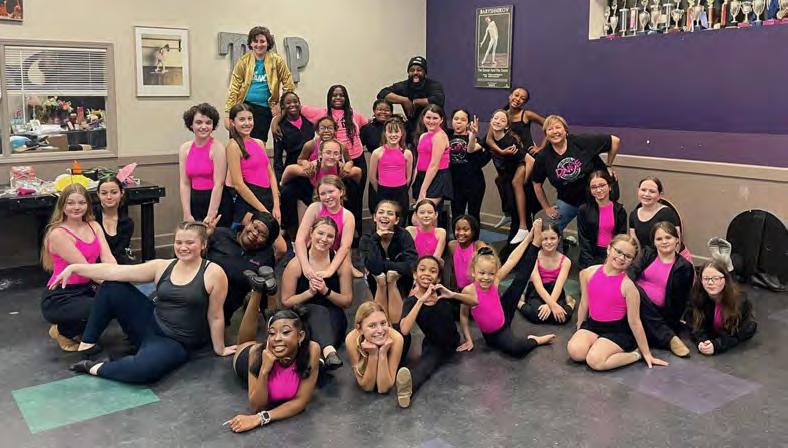
former student—now an adult—came back to visit and touch base. She began to share with me that the dance studio had been her safe place during a really difficult time in her life. She said it wasn't just the dancing that helped her, but the encouragement, the structure, and the sense of belonging she found here.
the difference. Moments like that remind me why I continue to teach day after day and year after year.
BOOM: Many of your former students now work alongside you. What does it mean to have that kind of multigenerational impact?
Tonya: One of the greatest honors for me is having a former students return—not just for a visit, but with a heart to teach, mentor, and invest in the next generation of dancers. It's deeply humbling. To know that the love for dance and the appreciation for the arts I once poured into them inspired a desire to continue that legacy—it means the world to me. There's something profoundly moving about those full-circle moments. These teachers remember what it felt like to stand where their students now stand and that empathy shapes how they teach. It creates a sense of continuity that's rich with meaning—a legacy woven from love, discipline, creativity, and joy. It reminds me that our impact as educators doesn't end with a single class, competition, or performance—it lives on in who our students become and what they choose to give back. My heart overflows with gratitude.
BOOM: Butch, you've continued creating beautiful art while facing Parkinson's for 17 years. How has painting helped you process and persevere?
Butch: Painting has been both a refuge and an escape from some of the challenges of living with Parkinson's. On days when my life seems overwhelming or my body doesn't cooperate the way it used to, painting has given me a way to redirect my focus from the physical or emotional challenges I am facing at that moment. Parkinson's has certainly changed some things for me, and it has deepened my appreciation for the creative process—teaching me to slow down, be present, and finding beauty in imperfection.
I once did, but what I've gained is a new kind of freedom—a reminder that creativity doesn't have to be perfect to be powerful.
BOOM: What adjustments have you both made as Parkinson's has become part of your shared journey?


In many ways, painting has helped me process my journey—the anxiety, frustration, gratitude, hope—all of it ends up on the canvas. It's taught me to keep showing up, even on the hardest of days. I may not have the same control
Butch: Through this journey, we've learned to walk through the challenges together—with patience, honesty, and a lot of grace. We've had to adjust not just routines but expectations. Some days move slower, and some plans have to be flexible. But through it all, we've stayed committed to being a team. We've made room for rest, for humor, and for asking for help when we need it. Tonya has become an amazing caregiver and a constant encourager, and I've had to learn to receive that love in new ways. I couldn't do this life without her. Tonya is my rock! This journey was not something we ever planned for our lives, but it certainly has deepened our partnership—not in spite of the struggle, but because of how we face it together. We've also become more intentional—about time, family, conversations, and what really matters in life. Parkinson's is part of our story now, but it doesn't define us. Love, faith, family, and creativity still lead the way!
BOOM: You're still making a difference, Butch, especially in your role with
Success Unlimited Academy. What do you love most about working with young people?
Butch: Following a twenty-five-year career with the United States Bankruptcy Court, I took disability retirement in 2014. While stepping away was necessary, it didn't take long—just a few months of reflection and rest—for me to realize I still had so much more to give. I appreciate Susan Alred, SUA's headmaster, for allowing me to join her administrative staff and have the privilege of working with both lower and upper school students.
What draws me to work with young people is their honesty, energy, and limitless potential. They're still discovering who they are, and being part of that journey is one of the greatest gifts of my life. I appreciate the opportunities not only to encourage them in their learning but to challenge them to dream bigger, believe in themselves, and truly understand that they matter. I've seen how even the smallest gestures—a kind word, a listening ear, a reminder of their worth—can have a lasting impact. I may not move as fast as I once did, but my passion for mentoring has never been stronger. Helping students see their God-given value and purpose—that's what keeps me going, and I cherish the opportunities I've had to mentor them.
BOOM: What advice would you give to others facing a long-term health challenge as a couple?


We encourage others to find joy even when it seems impossible! Celebrate small wins, create new routines, and stay connected to the things that make life meaningful— whether that's creativity, family, or just sitting together quietly enjoying a cup of coffee. You may have to adjust the rhythm of life, but you can still dance through it together.
BOOM: Between dance, art, education, and family, your lives are rich with connection. What grounds you both in the midst of it all?
What grounds us most is our faith and our commitment to each other. Life gets full— sometimes overwhelming— but we always come back to the foundation we built our marriage on: trusting God, staying rooted in love, and choosing to walk through life hand in hand.
We've learned that it's not about doing everything perfectly; it's about staying present, keeping our priorities clear, and remembering why we started this journey together. Whether we're in the studio, the office, or at home around the dinner table, we try to lead with grace and gratitude.
Our favorite part? —that's a tough question. As grandparents, we have the ability to slow down and truly savor each moment. When we were raising our daughters, Anne Preston and Frances, life was wonderfully full—but often very busy. Now, we get to enjoy the small things: the giggles, the curious questions, the bedtime stories and prayers, sleepovers, dance recitals and ballgames, the cookie baking, and the moments of just being silly together. There's no pressure—just presence. Their joy truly becomes our joy.
We're blessed with four beautiful grandchildren: Mary Colston (6), Eli (4),

At the end of the day, it's the simple things—prayer, shared moments, laughter, and knowing we're not alone in any of it—that keep us steady. Those are the things that hold us up, even when everything else feels like it's moving way too fast.
Olivia (3), and Brockton (2½). Each one has a distinct personality and brings something uniquely special to our hearts. They are, as Scripture reminds us, "fearfully and wonderfully made."
Our advice to others is this: face the challenge together, not alone. It's easy to let a diagnosis become the center of everything, but don't lose sight of your relationship. Keep talking, keep laughing, and keep showing up for each other in the little ways that matter. Give each other grace—because there will be hard days. Some are filled with frustration, some with fear, but don't be afraid to ask for help, and don't try to carry it all on your own. Lean on your faith, your family, your community, and each other.
BOOM: You've described your family as a huge joy — especially being grandparents. What's your favorite part of grandparenting?
Tonya: Oh my goodness—being grandparents has truly been one of the sweetest, most joy-filled chapters of our lives. There's a depth to it that's hard to explain until you've lived it—a love that is unconditional, full of wonder, and full of excitement. We're affectionately known as GaGa and PopPop, and we wear those names with pride.
Olivia's journey has been a uniquely precious part of our grandparenting story. Born with spina bifida and later diagnosed with Rubinstein-Taybi syndrome—a rare genetic condition— she has shown us what strength, beauty, and resilience truly look like. Each milestone she reaches is a victory, and her light continues to inspire not only us but our entire family. Her presence has deepened our love, our faith, and our perspective on what it means to cherish life's moments.
So, for us, grandparenting isn't just a season—it's a sacred calling. It's the opportunity to witness the unfolding of new generations and to speak life, faith, and love into their little hearts. More than anything, it's a blessing—a legacy of joy we are grateful to live every single day.
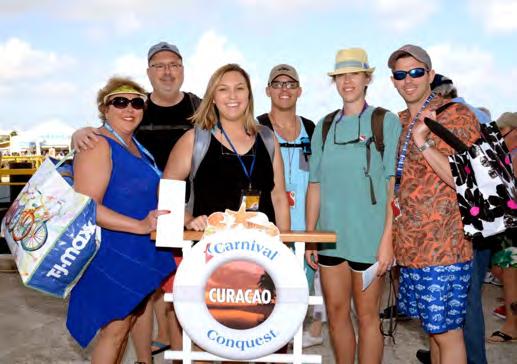
BOOM: Travel means something different to everyone. For you two, it sounds like it's not about destinations as much as togetherness. What makes your family trips so meaningful?
For us, family vacations have never been about the destination—it's about time together, shared laughter, and making meaningful memories. Whether we're exploring someplace new or revisiting a favorite spot, what matters most is simply being with the ones we love. Family trips give us the chance to step away from our busy life and focus on what matters most—each other. Some of our favorite memories are long car rides together, late-night games or movies, trips to the beach or mountains, cruises, boat rides at the lake and the joy of watching our children or grandchildren experience family vacations for the first time. There is always time for one more photo to take, one more cookie or
sweet treat for the grandchildren even when their parents say no more, or tweaking the bedtime routine. It's all worth it! We laugh, we play, we reflect—and we always come home feeling more grateful that we've made time for each other and created some special memories.
So for us, family trips aren't measured in miles, but measured in moments that draw us closer, remind us of what truly matters, and creates a legacy of love and togetherness. Those are the moments that stay with us long after we unpack our suitcases.
BOOM: Tonya, when we first spoke you said, "Life is good. Boom. Done. Period!" Where does that positivity come from?
Tonya: My positivity comes from a deep place of gratitude and faith. I've walked through seasons—some joyful, some painful—and have come to realize that life is a gift, even when it's hard. I choose to focus on what's good, what's true, and what lasts. It doesn't mean everything is always perfect—but it does mean I can find purpose and beauty in every day.

give, and create... that's more than enough!
BOOM: Looking back on your younger selves — newlyweds just starting out — what would you want to tell them today?
Looking back on our younger selves— wide-eyed newlyweds full of dreams— we'd tell them this: Be patient with each other, give more grace than you think you need, and hold tightly to your faith in God. You won't have all the answers, and that's okay, but seek out godly advice when necessary.
Life will bring joy and challenges you can't yet imagine, but if you face them together—with honesty, laughter, and a willingness to grow—you'll be stronger for it.
We'd also remind them that love isn't something you fall into once; it's something you choose, build, and nurture every single day. And that the life you're building— one step, one prayer, one sacrifice at a time—will be more meaningful than anything you could dream on day one. Trust the journey. The best is yet to come!

If you know Tonya, you know there's always a warm smile on her face and kind words spoken.
A big part of that mindset comes from my relationship with God. He's been faithful through every chapter, and that gives me strength and hope no matter what I'm facing. And honestly, it also comes from surrounding myself with people I love—my family, my students, my friends and community. They remind me that joy isn't about having everything go right; it's about recognizing the blessings right in front of you.
So yes—Life is good. Boom. Done. Period —because every day I wake up and get to love,
BOOM: What does "aging with purpose" mean to you, especially as a couple who's still dreaming, creating, and loving well?
For us, "aging with purpose" means continuing to live with intention, passion, and love—no matter what season of life we're in. It's about recognizing that growing older doesn't mean growing stagnant. In fact, it's quite the opposite. It's a conscious decision to wake up each day knowing that we still have something valuable to give. After 41 years of marriage, we're still dreaming, still creating, and still investing in the people and things we care most about—our family, our faith, our community, and each other. We will continue to walk hand-in-hand, cheering each other on, and staying open to all the beauty God still has in store for us.
We want to thank Tonya and Butch for sharing their story with us this month. If you have comments or suggestions about our cover profiles, including nominating someone, please text Jason Watson at 334.328.5189 or email jason@ riverregionboom.com.










Aging is a natural part of life, yet for many senior adults, it can also bring unexpected emotional and psychological challenges. The need to feel respected, to live with dignity, and to have a sense of purpose isn’t something that disappears with age. On the contrary, these needs become even more essential as seniors navigate transitions such as retirement, health changes, and loss of loved ones.
This is a valuable read especially for younger seniors—those in their 50s, 60s, and early 70s—who are now navigating how best to care for aging parents in their 80s and beyond. Understanding what matters most to our elders can help us support them with more empathy, intentionality, and love as they move into the final chapters of their journey.
In this article, we’ll explore why these elements are crucial for senior well-being and how individuals, families, communities, and caregivers can play a part in making sure every older adult continues to feel seen, valued, and inspired.
1. Respect Affirms Identity. Respect is about more than politeness—it’s a deep affirmation of a person’s worth. For seniors, being respected means being acknowledged for who they are, what they’ve contributed, and the wisdom they hold. As roles change with age (e.g., from worker to retiree, parent to grandparent), identity can begin to feel uncertain. When seniors are treated dismissively or as burdens, their sense of self can erode, leading to feelings of isolation, frustration, and even depression.
Conversely, when seniors are respected, they are reminded that they still matter—that their life has weight. Respect affirms that their stories are valuable and their perspectives count.
2. Dignity Promotes Mental and Emotional Health. Dignity is the feeling of being worthy of honor and care. When seniors are treated with dignity, it reinforces their autonomy, their right to make choices, and their humanity. Too often, aging adults are talked over, not to; decisions are made for them instead of with them.

Loss of dignity is one of the biggest contributors to depression and anxiety among the elderly. But when they are empowered to participate in decisions, whether about their healthcare or their daily routines, they experience better mental health and stronger relationships. Dignity also helps reduce feelings of helplessness and fosters a deeper sense of peace and control.
3. Purpose Fuels the Soul. Perhaps the most vital ingredient for senior well-being is purpose. After retirement or the loss of a spouse, many seniors struggle with the question, “What now?” Without a clear sense of direction, loneliness and meaninglessness can creep in.
A sense of purpose gives energy to the day. It might be as grand as volunteering in the community or as simple as tending a garden, mentoring a grandchild, or checking in on a friend. Seniors who report having a sense of purpose live longer, have lower rates of cognitive decline, and experience greater life satisfaction.
1. Listen to Their Stories and Validate Their Experiences. One of the most powerful acts of respect is simply listening. When we take time to ask about their life, their opinions, and their memories, we communicate that they matter. Intergenerational storytelling, memoir writing groups, or even casual conversations over coffee can help seniors feel recognized and understood.
Practical tip: Encourage children or grandchildren to interview their grandparents and document their life stories—it’s a gift to both generations.
2. Involve Seniors in Decisions About Their Lives. From living arrangements to medical care, involving seniors in decisions is a critical way to uphold their dignity. Even when cognitive or physical limitations are present, giving choices
whenever possible—what to wear, what to eat, how to spend the day—sends the message: You still have agency.
Practical tip: Use collaborative decisionmaking language like “What do you think?” or “How would you like to handle this?” instead of taking over or assuming.
3. Encourage Volunteerism and Community Involvement. Many seniors find joy in giving back, and volunteering can offer structure, socialization, and satisfaction. Whether it’s reading to schoolchildren, helping at a local food bank, knitting blankets for newborns, or mentoring younger adults, community engagement keeps minds and spirits alive.
Practical tip: Check with local nonprofits, libraries, churches, and senior centers for senior-specific volunteer programs.
4. Support Lifelong Learning and Hobbies. Intellectual stimulation doesn’t have an expiration date. Learning new skills or deepening existing interests helps seniors stay mentally

sharp and emotionally satisfied. From book clubs to painting classes, gardening to woodworking, these activities give meaning to the day and nurture a sense of identity.
Practical tip: Community colleges, libraries, and local organizations often offer discounted or free classes for seniors.
5. Design Spaces That Promote Independence and Comfort. A dignified life is often tied to the ability to live as independently as possible. Homes and community centers should be designed with accessibility and comfort in mind—from walk-in showers and grab bars to wide doorways and proper lighting.
Practical tip: Consider an occupational therapy consultation to assess home safety and independence opportunities.
6. Use Respectful Language and Attitudes. Avoid patronizing terms like
“sweetie” or “honey” unless the senior has expressed comfort with them. Speak to seniors like adults, not children. Avoid assumptions about their abilities based on age alone.
Practical tip: Model this behavior for children and others—language shapes how we perceive and value others.
7. Facilitate Social Connections. Isolation is one of the most serious threats to senior well-being. Whether living at home or in assisted care, maintaining strong social bonds is vital. Group activities, community meals, and regular visits from friends or family help restore a sense of belonging.
Practical tip: Encourage regular phone calls, video chats, or pen-pal relationships.
8. Celebrate Their Contributions.
Marking birthdays, anniversaries, or past achievements can be powerful reminders of a senior’s value. Publicly celebrating their impact on family, community,
or career helps renew their sense of relevance.
Practical tip: Create a “Legacy Wall” in a senior center, family home, or online where photos and stories can be displayed and shared.
When we honor our elders with respect, dignity, and purpose, we create a ripple effect across society. Families grow stronger. Communities become more compassionate. Younger generations learn the importance of empathy and heritage. We don’t just give seniors a better life—we make life better for everyone.
It’s time to shift our view of aging from one of decline to one of opportunity. Older adults are not relics of the past; they are pillars of our present and wisdom for our future. They are storytellers, mentors, friends, and innovators. When we give them what they truly need—respect, dignity, and purpose—we don’t just help them live longer. We help them live well. •

Some of my favorite childhood memories center around the "sweetheart" rose that grew in our yard. My mother had received it as a pass-along plant from a neighbor with a green thumb and a generous heart, and as a child, I loved it for many reasons. Since its buds and blooms were smaller than anything else we grew, I thought of it as "mine," child-sized as I was. To me, the buds looked like something a princess would have at her castle--delicate, fragile, gentle, and rare. And best of all, it was pink!
But this rose-scented fairy tale eventually came to an end, as fairy tales sometimes do. My father became fearful that the rose and its associated thorns were too close to the in-ground trampoline he had bought for me, surely another possession of every princess on her castle grounds. So he cut it down. I mourned its passing, especially while jumping on the trampoline, and went on the lookout whenever roses were near to see if I could find it again.
Today, I can report that, at least so far, I have not found it again, but I have found and enjoyed many of its lovely sisters on my real-girl castle grounds. When I bought a house, the previous owners left behind almost thirty roses,
pamphlet and publication on roses offered by the Extension Service, I found again my childhood love of the flower and discovered that I also loved taking care of them. When Stuart and I married, I gained a partner who matched me in so many ways, not the least of which was a heart for all growing things, including roses. The story continued, and through the years, our rose collection grew as our yard shrank until we were caring for well over fifty bushes. Did I mention that sometimes, even a fairy tale can get out of control?
But no self-respecting fairy tale is complete without an evil villain, and ours was about to make an appearance. Several years ago, we noticed unusual red and spiky growth on some of our bushes. When the growth morphed into clusters of short branches that resembled witches' brooms (and how appropriate is that for a fairy tale story?), we knew we were in big trouble. Rose rosette disease had found our world.
According to the Alabama Extension Service, Rose rosette disease is caused by the Rose rosette virus and is transmitted from plant to plant by the microscopic eriophyid mite. It was first identified in the 1940's and, to date, has spread to at

wings, their transportation is dependent on outside agents. They travel, sometimes as much as two miles, on air currents or catch a ride on an animal, human, or garden tool. When they land on a new plant and begin to chew, the virus has claimed another victim. Once the disease is present, the best advice is to destroy the entire host plant as quickly as possible by bagging all the clippings, canes, and roots to ensure that no mites escape, causing more damage. We lost twenty-three roses to Rose rosette disease in the space of two years.
But things are looking up again in our garden story. What we feared was another outbreak was diagnosed by the Extension Plant Pathology Lab as chemical damage, probably from lawn treatments. And we are planting again! This spring, we are back up to thirty-seven roses and making plans for more. That might not be a "happily ever after" for everyone, but it's good enough for us--at least for now!





The statistics can’t be denied. Seventy percent of Americans will need longterm care before they die. On average, someone needing long-term care will receive over four years of care in their home and then will go on to a facility, such as an assisted living, a memory care facility or a nursing home for another two years. Long-term care includes assistance with bathing, dressing, eating, moving around, toileting or incontinence due to physical limitations or cognitive impairment.
The interesting dynamic is how differently men and women tend to view long-term care, which relates to how they tend to think about risk. Harley Gordon, an influential elder law attorney, wrote a book about it, “The Conversation,” Helping Someone You Love Plan for an Extended Care Event.” He notes, “Men are wired to minimize if not dismiss risk in life. If there is no risk of a serious event happening, what consequences can there be? If there are no consequences, why put together a plan?” Whereas he says, “Women have an aversion to risk. They see the risk of serious event and the consequences of it as being inseparable.”
Gordon observes that trying to motivate men to plan for long-term care with the statistics doesn’t work because they don’t believe it will happen to them,
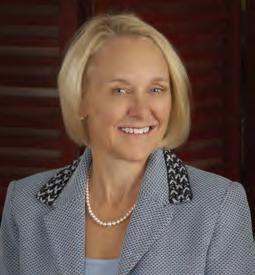
By Susan Clayton Moore, J.D. Principal of Moore Wealth Management, Inc.
whereas women hope it won’t but understand that the odds are that it will. He recommends that since men are most motivated by taking care of those they love, the conversation about planning for long-term care needs to focus on the consequences to those they love if they fail to take action and long-term care is needed.
The cost of long-term care can be prohibitive. Genworth, in its annual 2024 Cost of Care Survey, estimated that a home health aide in Auburn, AL, costs $5,720 a month or $68,640 annually. The cost of an assisted living facility in Montgomery was estimated to be $3,780 a month, or $45,360 a year. So, six


years of receiving long-term care in the Auburn area currently costs in excess of $800,000.
There are multiple ways to financially plan for long-term care, including traditional insurance, hybrid types of life insurance and long-term care insurance, long-term care annuities, self-insuring, etc. These methods will be covered in a webinar format on Wednesday, July 30th at 12 p.m. Please call 256.234.2761, or email Sarah@moorewealthmanagement.com for more information and reservations.
Susan Clayton Moore, J.D., is a financial advisor and wealth manager of Moore Wealth Management, Inc., with offices Montgomery and Alexander City, AL. Susan has under advisement over $150 million (as of 9.1.24) in brokerage and advisory assets through Kestra Financial and has been a financial planner for over 40 years. Contact Susan at 334.270.1672. Email contact is susan@ moorewealthmanagement.com.
The opinions expressed in this commentary are those of the author and may not necessarily reflect those held by Kestra Investment Services, LLC or Kestra Advisory Services, LLC. This is for general information only and is not intended to provide specific investment advice or recommendations for any individual. It is suggested that you consult your financial professional, attorney or tax advisor regarding your individual situation. Securities offered through Kestra Investment Services, LLC (Kestra IS), member FINRA/SIPC. Investment Advisory Services offered through Kestra Advisory Services, LLC (Kestra AS), an affiliate of Kestra IS. Kestra IS or Kestra AS are not affiliated with Moore Wealth Management, Inc. https://www. kestrafinancial.com/disclosures



